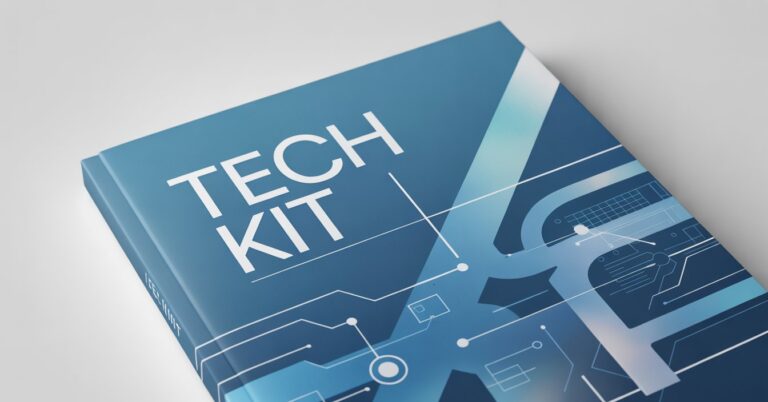Generative AI Forcing Legal Profession to Rethink the Billable Hour
Artificial Intelligence is transforming how lawyers work, creating a fundamental disconnect between time spent and value delivered. As automation compresses hours for routine tasks, clients increasingly demand pricing that reflects results rather than effort. The legal profession now faces pressure to abandon its reliance on hourly billing and embrace models that align compensation with outcomes.
When Effort No Longer Equals Value
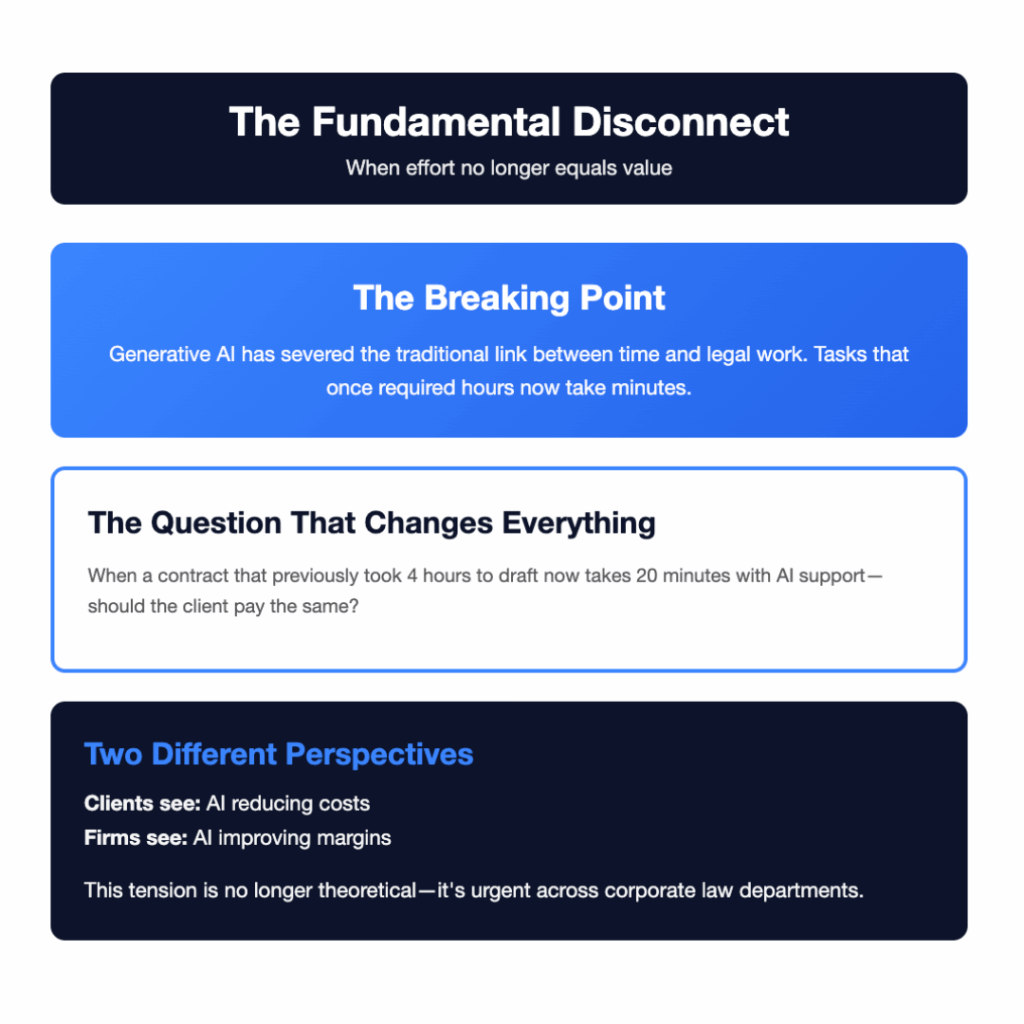
Generative AI has severed the traditional link between time and legal work. Tasks that once required hours now take minutes. Document review that consumed days of associate time now completes in hours with AI assistance. Yet many firms continue billing by the hour for work that automation has made faster and cheaper.
The disconnect creates tension. Clients see AI as reducing costs; firms see it as improving margins. When a contract that previously took four hours to draft now takes twenty minutes with AI support, should the client pay the same? The question has moved from theoretical to urgent across corporate law departments.
According to Thomson Reuters’ 2025 State of the U.S. Legal Market, the legal profession must rethink how it defines value when pricing services. The report warns that continued reliance on input-driven models like the billable hour will become increasingly untenable as generative AI expands its capabilities.
Corporate Buyers Push for Change
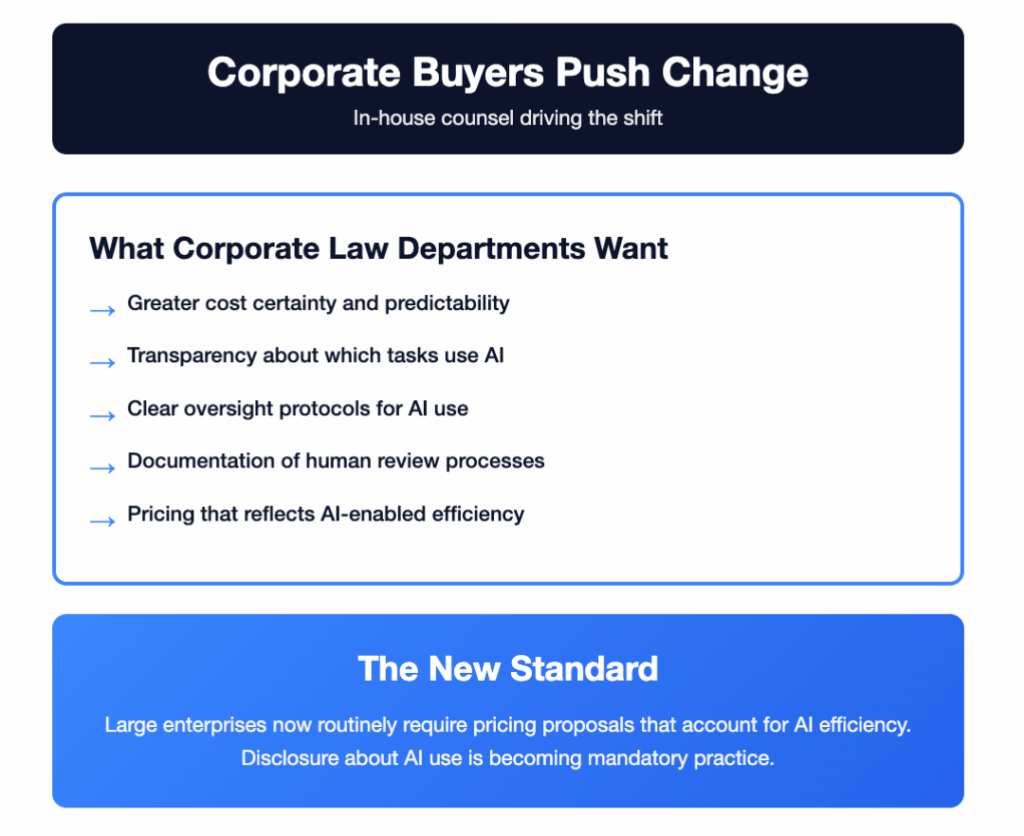
In-house counsel are driving the shift toward more predictable pricing. According to the Association of Corporate Counsel’s 2025 Law Department Management Benchmarking Report, hourly billing remains the default, but legal departments increasingly favor models that offer greater cost certainty. Fixed or flat fees are gaining traction in intellectual property work, while capped fees are becoming more common in litigation and mergers and acquisitions.
The trend reflects a broader preference for transparency and control over legal spend. Core functions continue to be handled internally, allowing departments to retain expertise and manage costs for routine or sensitive matters, while specialized work such as intellectual property and discovery is still frequently outsourced. The report also notes a gradual rise in the use of alternative legal service providers for niche or technology-driven tasks, suggesting a growing comfort with hybrid delivery models that balance efficiency with oversight.
Large enterprises now routinely require pricing proposals that account for AI-enabled efficiency. Corporate law departments increasingly demand transparency about which tasks use AI, what oversight protocols exist, and how human review occurs. This disclosure requirement is becoming standard practice across the profession.
How Law Firms Are Responding
Firm responses vary by market position. Global practices continue hourly billing for complex matters while experimenting with hybrid approaches that blend fixed fees for routine work with premium rates for strategy. Mid-size firms are moving more aggressively toward subscription models where clients pay predictable monthly fees covering research, drafting, and advisory services.
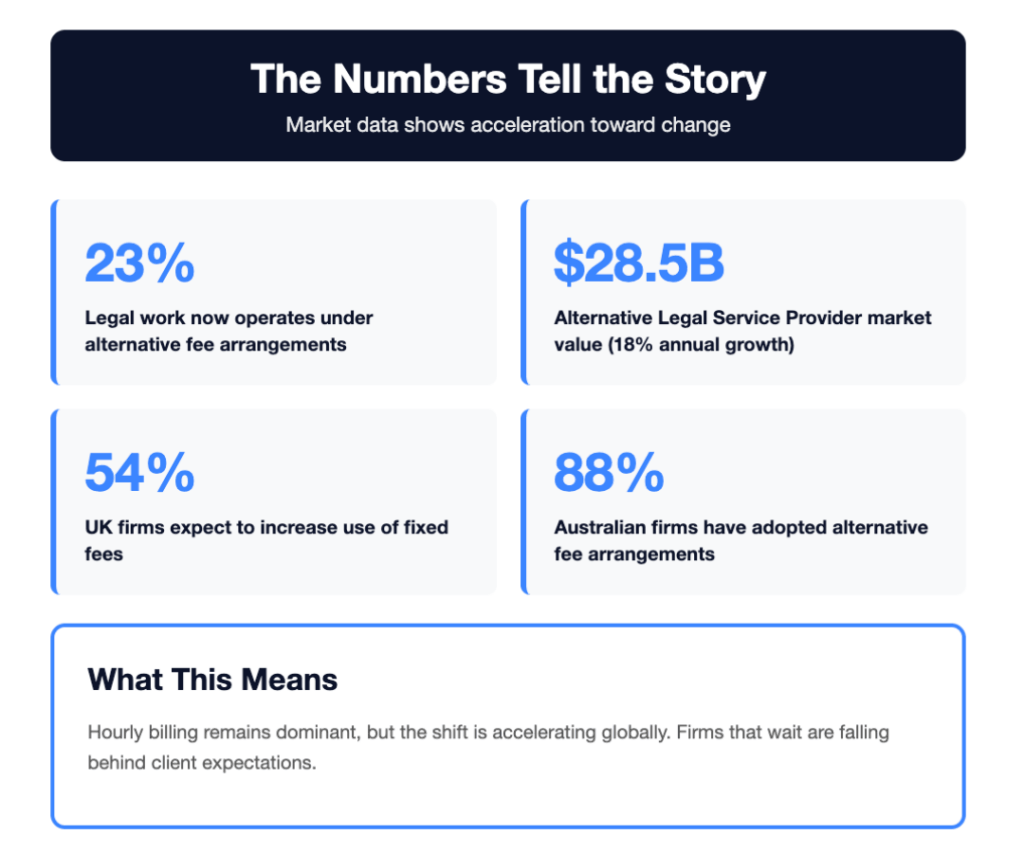
Thomson Reuters’ Alternative Legal Services Providers Report 2025 values the ALSP sector at 28.5 billion USD, showing 18 percent compound annual growth from 2021 to 2023. These providers build business models around automation and fixed pricing, demonstrating that alternatives to hourly billing can scale profitably.
Currently, 23 percent of legal work operates under alternative fee arrangements, according to data from Bloomberg and Wolters Kluwer. While that figure represents growth from a decade ago, it also shows that hourly billing remains dominant despite acknowledged limitations.
Global Adoption Patterns
The shift toward alternative pricing extends beyond US borders. According to legal software company Clio, 54 percent of UK firms expect to increase the use of fixed fees, moving away from traditional hourly billing structures. The trend reflects growing client demand for cost transparency and predictability across major legal markets.
Australian firms face similar pressure. A 2024 survey by Litera found that 88 percent of Australian law firms have adopted alternative fee arrangements, with more than half changing their pricing models in response to economic pressures.
The European Union’s AI Act, which entered into force in August 2024, introduces transparency obligations that affect legal service delivery across member states. The regulation requires disclosure when AI systems interact with users and mandates that AI-generated content be identifiable. While the Act does not directly regulate pricing, its transparency requirements for AI use in professional services create additional pressure for value-based billing models that account for automation.
Ethical Requirements and Oversight

The American Bar Association’s Formal Opinion 512 connects AI use directly to Model Rule 1.5, which requires fees to be reasonable and transparent. Lawyers who use AI must supervise its output and disclose its role when it materially affects representation. Billing human rates for predominantly automated work could violate that standard.
Florida Bar Advisory Opinion 24-1 reinforces these requirements. The opinion mandates informed consent when client data enters AI systems and requires disclosure when automation plays a significant role in work product. These guidance documents push firms toward pricing transparency and away from billing models that obscure the actual effort required.
The ethical framework implies that responsible AI adoption means adjusting rates to reflect efficiency gains rather than maintaining pre-automation pricing for faster work. The principle echoes longstanding guidance that lawyers sell expertise and judgment, not minutes.
Academic Analysis of Billing Models
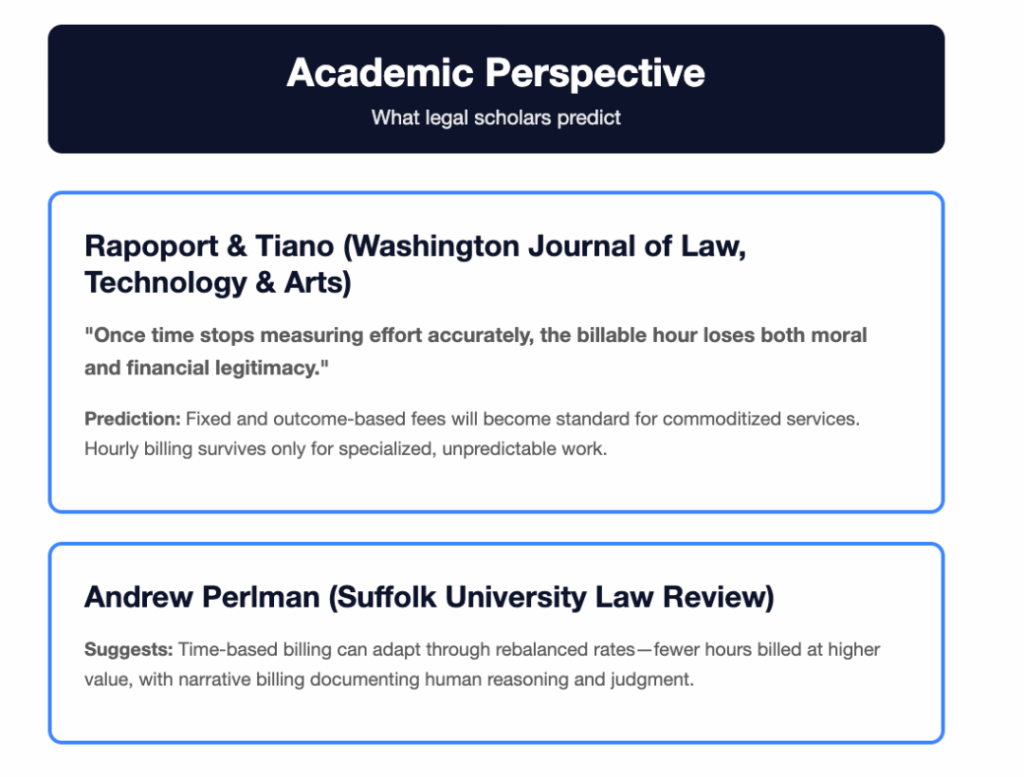
Legal scholars are examining the economic consequences of AI-driven efficiency. In “Fighting the Hypothetical: Why Law Firms Should Rethink the Billable Hour in the Generative AI Era” published in the Washington Journal of Law, Technology and Arts, professors Nancy B. Rapoport and Joseph R. Tiano Jr. argue that once time stops measuring effort accurately, the billable hour loses both moral and financial legitimacy. They predict fixed and outcome-based fees will become standard for commoditized services, while hourly billing survives only for specialized work in unpredictable matters.
Andrew Perlman offers nuance in “The Legal Ethics of Generative AI” published in the Suffolk University Law Review. He suggests time-based billing can adapt through rebalanced rates that reflect efficiency while preserving profitability. His model envisions fewer hours billed at higher value, with narrative billing that documents human reasoning and judgment.
Dana Remus and Frank Levy’s “Can Robots Be Lawyers?” remains influential for its analysis of how automation reshapes rather than replaces legal labor. For broader context on market structure and regulatory frameworks, Gillian Hadfield’s Rules for a Flat World provides essential background.
Professional Liability Insurance Concerns
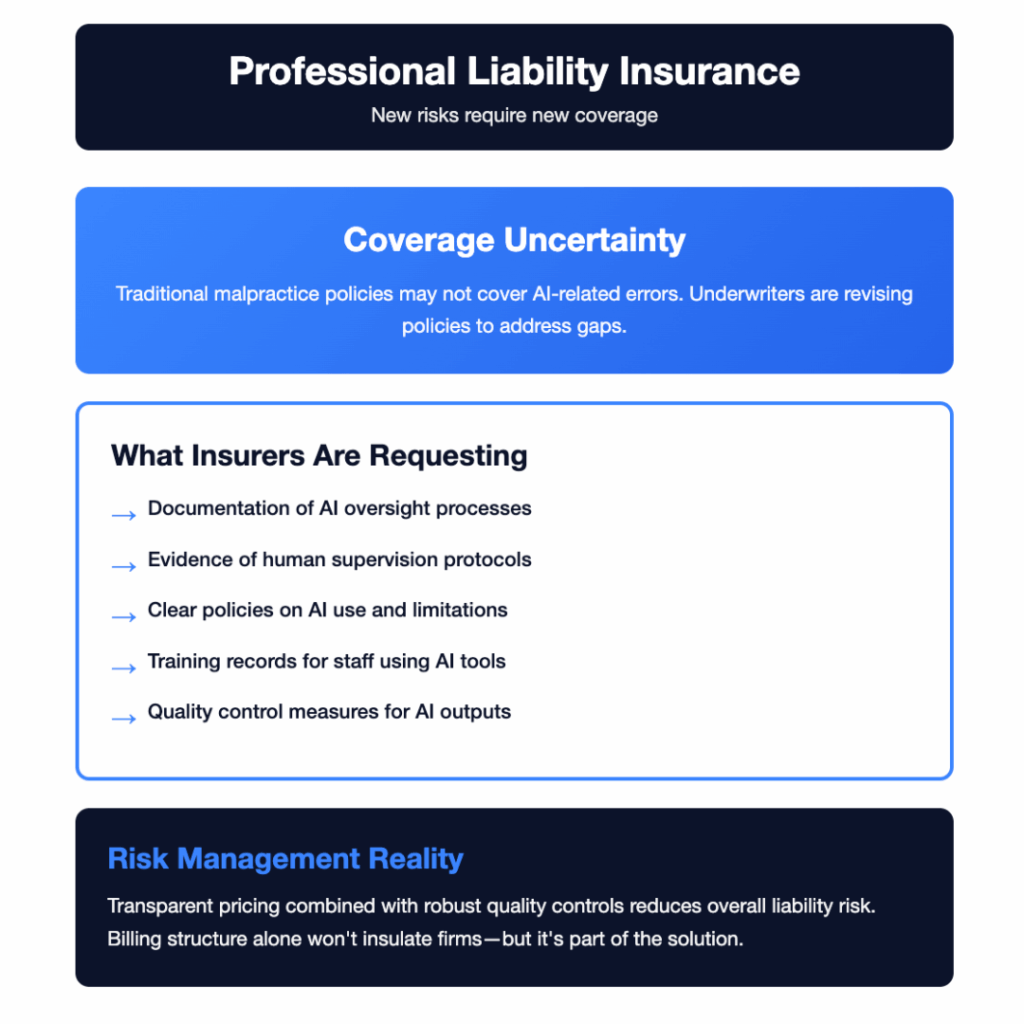
Professional liability insurers are scrutinizing AI-related risk. An ABA Journal investigation published in February 2025 found that coverage for AI-related errors remains uncertain. Underwriters are revising policies to address gaps in traditional malpractice coverage when AI tools contribute to mistakes or oversights.
Flat-fee arrangements can reduce exposure to billing disputes but create new questions about competence and supervision standards. Major carriers now request documentation of AI oversight processes in renewal applications. The insurance industry’s response suggests that billing structure alone will not insulate firms from liability, but transparent pricing combined with robust quality controls may reduce overall risk.
Practical Implementation for Law Firms
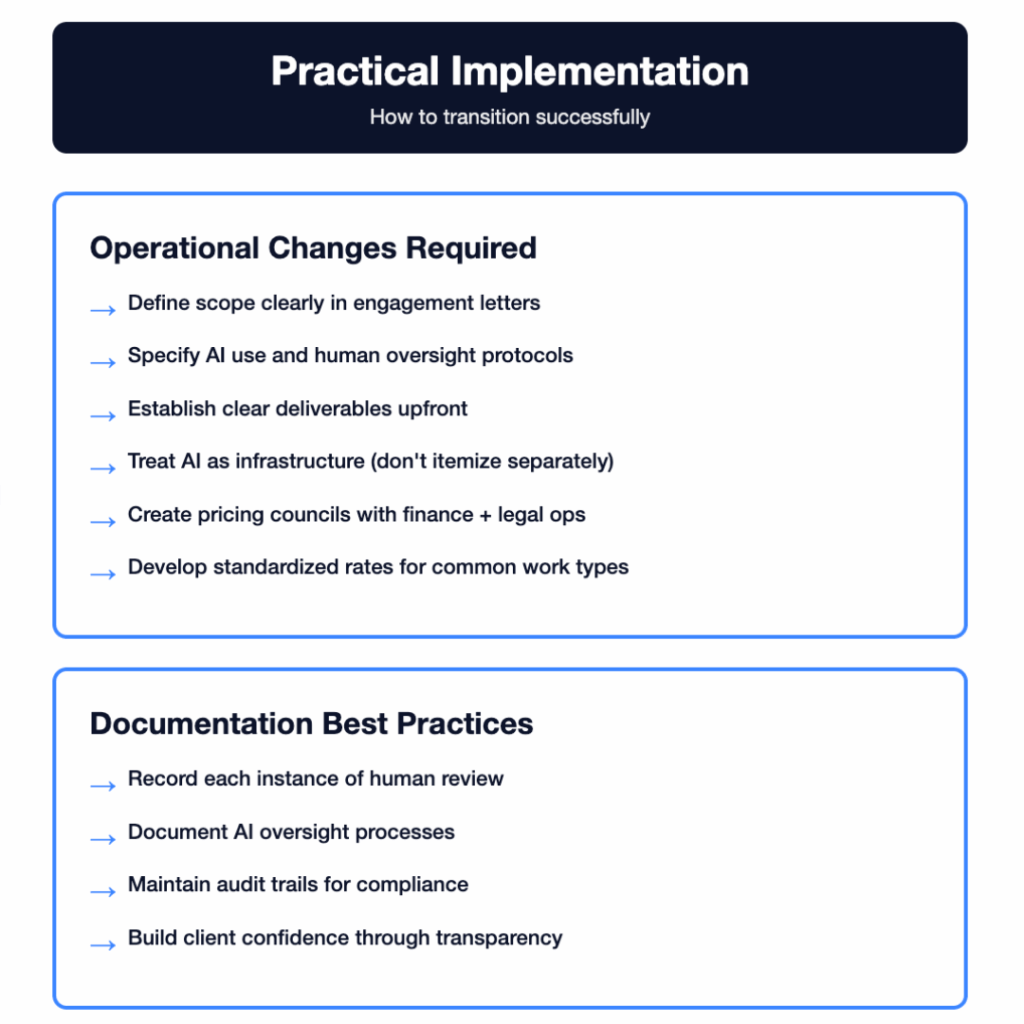
Transitioning from hours to value requires operational changes. Engagement letters should define scope, specify AI use and human oversight, and establish clear deliverables. Firms should treat AI as infrastructure rather than itemizing it as a separate charge. Creating pricing councils that include finance professionals, partners, and legal operations specialists helps develop standardized rates for common work types.
Documentation matters for both compliance and client confidence. Recording each instance of human review, particularly where AI generates or summarizes legal content, strengthens adherence to ethics opinions and meets client transparency expectations. These practices protect professional reputation while demonstrating responsible innovation.
Clients do not expect free automation. They expect fair compensation for the value received. Explaining how AI contributes to efficiency without inflating costs builds trust and positions firms as partners rather than vendors. That relationship foundation will likely prove more valuable than hourly rate optimization in long-term client retention.
Where Hourly Billing Still Works

The billable hour is not obsolete. Complex litigation, high-stakes arbitration, and cross-border transactions still justify hourly rates because strategy, uncertainty, and human judgment dominate the work. In these contexts, clients prefer flexibility over fixed commitments. What is disappearing is the assumption that every legal task must be priced by time. The hour survives where unpredictability genuinely exists.
Emerging Regulatory Requirements
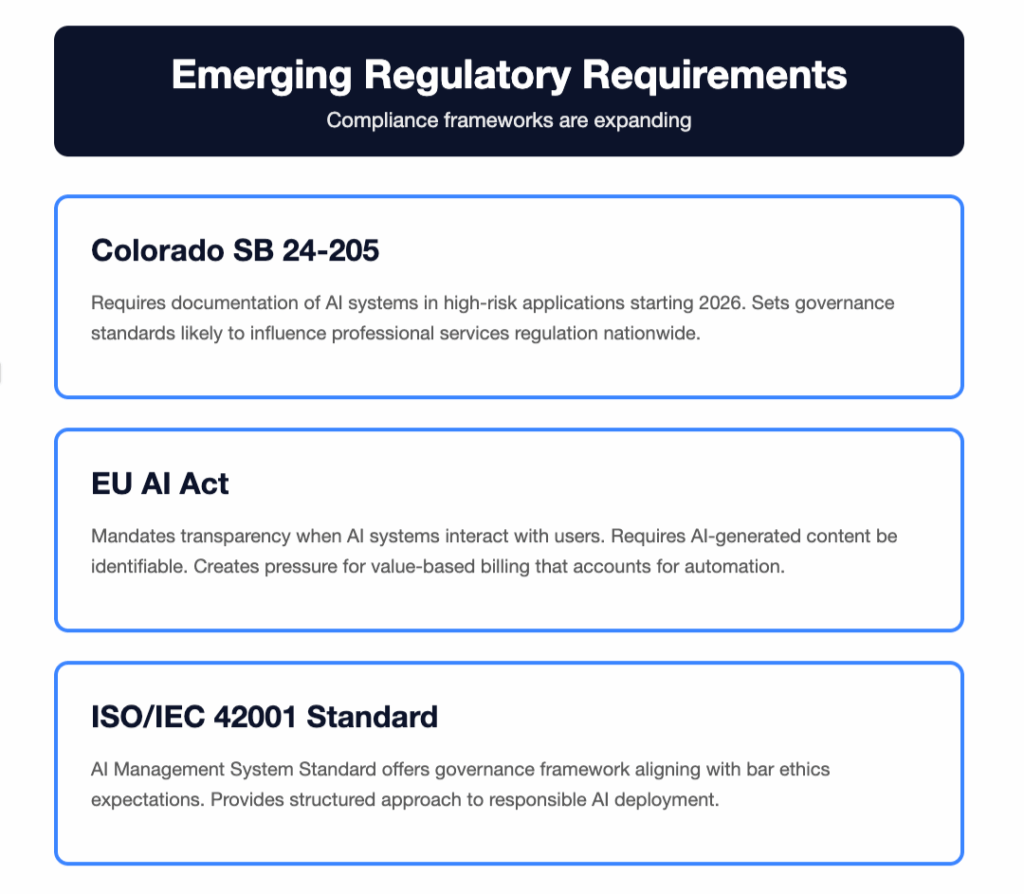
State regulators are expanding transparency requirements. Colorado’s SB 24-205 requires documentation of AI systems used in high-risk applications starting in 2026. While the law primarily targets consumer-facing AI, its documentation and governance standards will likely influence professional services regulation.
The ISO/IEC 42001 AI Management System Standard offers firms a governance framework that aligns with bar ethics expectations. These evolving standards push legal billing toward models where value and reasoning, rather than time, define professional worth.
Firms that adapt successfully will treat AI as leverage that enhances human expertise rather than as a cost-cutting shortcut. They will price work based on outcomes and quality of judgment rather than hours logged. Those that continue optimizing only for hourly rate maximization will find themselves competing in a shrinking market.
Sources
- American Bar Association: Formal Opinion 512 on Generative AI Tools (July 29, 2024)
- American Bar Association: “Does Your Professional Liability Insurance Cover AI Mistakes? Don’t Be So Sure” (ABA Journal, February-March 2025)
- Association of Corporate Counsel: 2025 Law Department Management Benchmarking Report (June 17, 2025)
- Colorado General Assembly: SB 24-205 Artificial Intelligence Act (2024)
- European Union: Artificial Intelligence Act (August 2024)
- Florida Bar: Advisory Opinion 24-1 on AI and Client Confidentiality (January 19, 2024)
- Hadfield, Gillian K.: Rules for a Flat World (Oxford University Press, 2016)
- International Association of Insurance Supervisors: Application Paper on the Supervision of Artificial Intelligence (July 2, 2025)
- International Organization for Standardization: ISO/IEC 42001 Artificial Intelligence Management System Standard (2023)
- Law Society of England and Wales: Key Trends Shaping the Legal Industry in 2025 (2025)
- Litera: Economic Pressures Drive Australian Law Firms to Alternative Fee Models (SmartCompany, June 2024)
- Lloyd’s Market Association: The Impact of Artificial Intelligence on the International E&O Market (Sept. 18, 2025)
- Perlman, Andrew M.: “The Legal Ethics of Generative AI” (Suffolk University Law Review, 2024)
- Rapoport, Nancy B. and Joseph R. Tiano Jr.: “Fighting the Hypothetical: Why Law Firms Should Rethink the Billable Hour in the Generative AI Era” (Washington Journal of Law, Technology & Arts, Vol. 20, 2025)
- Remus, Dana and Frank Levy: “Can Robots Be Lawyers?” (Harvard Law School, 2016)
- Thomson Reuters: Alternative Legal Services Providers Report 2025 (January 2025)
- Thomson Reuters: State of the U.S. Legal Market 2025 (January 2025)
- Wolters Kluwer: “Striking the Balance: How to Make Alternative Fee Arrangements Work for Everyone” (August 2025)
This article was prepared for educational and informational purposes only. It does not constitute legal advice and should not be relied upon as such. All cases, statutes, and sources cited are publicly available through official publications and reputable outlets. Readers should consult professional counsel for specific legal or compliance questions related to AI use.
See also: How Law Firms Can Build a Compliance Framework for AI Governance and Risk

Jon Dykstra, LL.B., MBA, is a legal AI strategist and founder of Jurvantis.ai. He is a former practicing attorney who specializes in researching and writing about AI in law and its implementation for law firms. He helps lawyers navigate the rapid evolution of artificial intelligence in legal practice through essays, tool evaluation, strategic consulting, and full-scale A-to-Z custom implementation.



